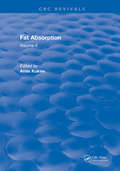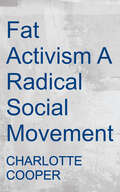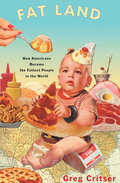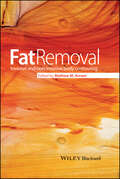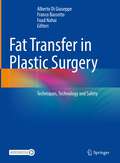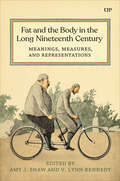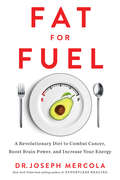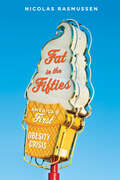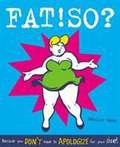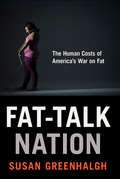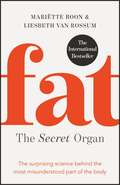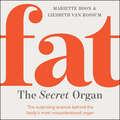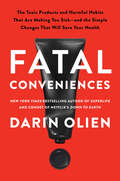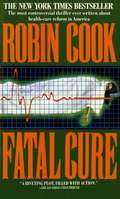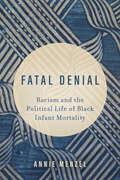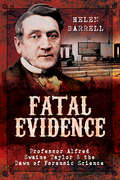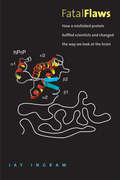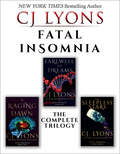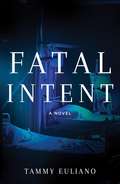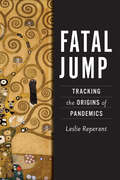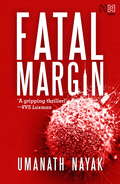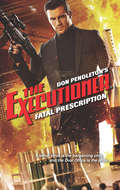- Table View
- List View
Fat Absorption: Volume II
by Arnis KuksisThis book provides an authoritative and comprehensive source of information on the biochemical an metabolic aspects of digestion and absorption of different dietary fats and other lipids, with minimal discussion of the physical chemistry of the process, which has been covered in great detail in previous reviews. It is intended for both researchers and practitioners in the biomedical field who require detailed knowledge of the biomedical and metabolic transformations involed in the intestinal digestion and resynthesis of dietary fats and other lipids.
Fat Activism: A Radical Social Movement
by Charlotte CooperWhat is fat activism and why is it important? To answer this question, Charlotte Cooper presents an expansive grassroots study that traces the forty-year history of international fat activism and grounds its actions in their proper historical and geographical contexts. She details fat activist methods, analyzes existing literature in the field, challenges long-held assumptions that uphold systemic fatphobia, and makes clear how crucial feminism and queer theory are to the lifeblood of the movement. She also considers fat activism’s proxy concerns, including body image, body positivity, the obesity epidemic, and fat stigma. <p><p>Combining rigorous scholarship with personal, accessible writing, Fat Activism: A Radical Social Movement is not only an invaluable contribution to the burgeoning field of fat studies, but also a vehicle for much-needed social change.
Fat Detection: Taste, Texture, and Post Ingestive Effects (Frontiers in Neuroscience)
by Jean-Pierre Montmayeur Johannes le CoutrePresents the State-of-the-Art in Fat Taste TransductionA bite of cheese, a few potato chips, a delectable piece of bacon - a small taste of high-fat foods often draws you back for more. But why are fatty foods so appealing? Why do we crave them? Fat Detection: Taste, Texture, and Post Ingestive Effects covers the many factors responsible for the se
Fat Land: How Americans Became the Fattest People in the World
by Greg Critser&“An in-depth, well-researched, and thoughtful exploration of the &‘fat boom&’ in America.&” —TheBoston Globe Low carb, high protein, raw foods . . . despite our seemingly endless obsession with fad diets, the startling truth is that six out of ten Americans are overweight or obese. In Fat Land, award-winning nutrition and health journalist Greg Critser examines the facts and societal factors behind the sensational headlines, taking on everything from supersize to Super Mario, high-fructose corn syrup to the high costs of physical education. With a sharp eye and even sharper tongue, Critser examines why pediatricians are now treating conditions rarely seen in children before; why type 2 diabetes is on the rise; the personal struggles of those with weight problems—especially among the poor—and how agribusiness has altered our waistlines. Praised by the New York Times as &“absorbing&” and by Newsday as &“riveting,&” this disarmingly funny, yet truly alarming, exposé stands as an important examination of one of the most pressing medical and social issues in the United States. &“One scary book and a good companion to Eric Schlosser&’s Fast Food Nation.&” —Seattle Post-Intelligencer
Fat Removal
by Mathew AvramThe perception of an inadequate body shape is a cause of concern to many people, and new techniques for altering body shape are increasingly being developed and offered to patients. Of these, the removal and transfer of fat is fast growing in importance and availability. This practical guide offers a comprehensive overview of this rapidly-evolving field, and thorough coverage of the implementation of fat removal techniques, both invasive and non-invasive, in a cosmetic practice. It begins with an overview of basic fat anatomy and physiology as an important introduction to this topic. The distinction between the physiology and treatment of cellulite and fat is also discussed. The next section of the book covers invasive treatments of fat such as traditional liposuction, laser-assisted liposuction, fat transfer procedures and mesotherapy. The latter half of the book largely focuses on non-invasive treatments for fat, including radiofrequency, ultrasound, cooling and laser technologies for fat removal. Throughout, potential complications and pitfalls of the various treatments are discussed. Edited by Matthew Avram, with contributions from a group of clinical stars, this book will appeal to cosmetic dermatologists, plastic surgeons, aesthetic medical practitioners, and obstetricians/gynaecologists
Fat Transfer in Plastic Surgery: Techniques, Technology and Safety
by Alberto Di Giuseppe Franco Bassetto Foad NahaiOnly in recent years new available technologies, the redefinition and refining of intervention techniques, and clinical research studies have widened the spectrum of fat applications in aesthetic and reconstructive surgery. Fat grafting is nowadays one of the most used techniques in plastic reconstructive surgery, as primary method or as an ancillary procedure. The optimized ratio of fat survival has led to standardized techniques followed by most practitioners.The aim of this book is to present up-to-date technologies used for fat extraction, and fat harvesting: latest tools are evaluated examining pros and cons. All recent techniques in aesthetic and reconstructive surgery and their outcomes are described in a clear, comprehensive manner; chapters present the latest research results in stem cell and regenerative medicine, their application to plastic and reconstructive surgery, in particular for hand surgery, ulcer, and capsule contractures in post breast augmentation procedures. Related specific techniques as breast fat transfer, breast hybrid implant, fat transfer and buttock fat transfer are also discussed. Safety issues in fat transfer procedures are examined accurately, particularly those involving buttock fat transfer. Each procedure is completed by a scientific analysis of the main reasons for complications, how to prevent them and the safety guidelines recommended as golden standard to be followed. The surgical part contains clinical cases related to each chapter topic, videos, and all chapters have a box with take home messages. An invaluable tool for correct decision-making for clinicians, fellows and residents in plastic surgery, Fat Transfer in Plastic Surgery focuses on indications, applications and surgical techniques for each individual body district, and safe and reliable procedures in the application of latest technology. district, and safe and reliable procedures in the application of latest technology. district, and safe and reliable procedures in the application of latest technology. district, and safe and reliable procedures in the application of latest technology. district, and safe and reliable procedures in the application of latest technology. district, and safe and reliable procedures in the application of latest technology. district, and safe and reliable procedures in the application of latest technology. district, and safe and reliable procedures in the application of latest technology. district, and safe and reliable procedures in the application of latest technology. district, and safe and reliable procedures in the application of latest technology.
Fat and the Body in the Long Nineteenth Century: Meanings, Measures, and Representations
by V. Lynn Kennedy Amy J. ShawIn the nineteenth and early twentieth centuries, the body was a key focus of discourse. Fat and the Body in the Long Nineteenth Century animates discussion and analyses of fatness, highlighting how corporeal expectations fit into larger social systems and showing how interpretations have shifted over time. This collection examines a host of primary sources – including literature, art, medical treatises, journalism, political cartoons, soldiers’ letters home, and popular fiction – to identify trends in how fat was perceived and promoted in the English-speaking world over the long nineteenth century. Divided into four thematic sections, the book addresses epistemologies, artistic and literary representations, the turn towards quantification and measurement, and the connections to imperialism and colonialism. It explores the complex debate about the meaning of fat and its signalling of health, beauty, moral strength, and class status. The book shows how contemporary presentations and discussions of fat offer insights into ideals of gender and race and the processes of imperialism and of professionalization in the social sciences and medicine. By tracing how debates shifted over time, the book ultimately reveals that there was no universal interpretation of fat as a positive or negative characteristic throughout the nineteenth century.
Fat for Fuel: A Revolutionary Diet To Combat Cancer, Boost Brain Power, And Increase Your Energy
by Dr Joseph MercolaFor over a century, we’ve accepted the scientific consensus that cancer results from genetic disease due to chromosomal damage in cell nuclei. But what if cancer isn’t a genetic disease after all? What if scientists are chasing a flawed paradigm, and cancer isn’t a disease of damaged DNA but rather of defective metabolism as a result of mitochondrial dysfunction? What if that startling truth could revolutionize our understanding of other diseases as well —and show us a radical new path to optimal health?In this groundbreaking guide, the first of its kind, New York Times best-selling author and leading natural-health practitioner Joseph Mercola explains how nearly all disease is caused by defective metabolic processes. Then he reveals what’s really causing your metabolism to go haywire: damage and dysfunction in the mitochondria, thousands of which are at work in nearly every cell in your body, generating 90 percent of the energy you need to stay alive and well. When mitochondria become damaged in large numbers, it is impossible to stay healthy.Dr. Mercola shows you that you can to take control of your health simply by giving your body the proper fuel —and it’s not what you’ve likely been led to believe. A ketogenic diet, very low in carbohydrates and high in healthy fats, is the way to optimize the biochemical pathways that suppress disease and support healing. And the benefits can be astonishing —not only in treating or preventing serious illness, but in boosting your brainpower, increasing your energy, helping you lose weight and keep it off, and much more.As you read this book, you’ll learn in clear, rational terms how your body works at a molecular level. You’ll finally understand the type of fuel it’s designed to burn in the most efficient way possible. You’ll find detailed guidelines for starting and sticking with a ketogenic eating plan. And you won’t have to wait a decade or two for metabolic mitochondrial therapy to make its way into the mainstream. You can build a healthier body and brain at the cutting edge of this exciting new discipline, starting right now.
Fat in the Fifties: America's First Obesity Crisis
by Nicolas RasmussenA riveting history of the rise and fall of the obesity epidemic during 1950s and 1960s America.Metropolitan Life Insurance Company identified obesity as the leading cause of premature death in the United States in the 1930s, but it wasn't until 1951 that the public health and medical communities finally recognized it as "America's Number One Health Problem." The reason for MetLife's interest? They wanted their policyholders to live longer and continue paying their premiums. Early postwar America responded to the obesity emergency, but by the end of the 1960s, the crisis waned and official rates of true obesity were reduced— despite the fact that Americans were growing no thinner. What mid-century factors and forces established obesity as a politically meaningful and culturally resonant problem in the first place? And why did obesity fade from public—and medical—consciousness only a decade later? Based on archival records of health leaders as well as medical and popular literature, Fat in the Fifties is the first book to reconstruct the prewar origins, emergence, and surprising disappearance of obesity as a major public health problem. Author Nicolas Rasmussen explores the postwar shifts that drew attention to obesity, as well as the varied approaches to its treatment: from thyroid hormones to psychoanalysis and weight loss groups. Rasmussen argues that the US government was driven by the new Cold War and the fear of atomic annihilation to heightened anxieties about national fitness. Informed by the latest psychiatric thinking—which diagnosed obesity as the result of oral fixation, just like alcoholism—health professionals promoted a form of weight loss group therapy modeled on Alcoholics Anonymous. The intervention caught on like wildfire in 1950s suburbia. But the sense of crisis passed quickly, partly due to cultural changes associated with the later 1960s and partly due to scientific research, some of it sponsored by the sugar industry, emphasizing particular dietary fats, rather than calorie intake.Through this riveting history of the rise and fall of the obesity epidemic, readers gain an understanding of how the American public health system—ambitious, strong, and second-to-none at the end of the Second World War—was constrained a decade later to focus mainly on nagging individuals to change their lifestyle choices. Fat in the Fifties is required reading for public health practitioners and researchers, physicians, historians of medicine, and anyone concerned about weight and weight loss.
Fat! So?: Because You Don't Have To Apologize For Your Size
by Marilyn WannFat? Chunky? Less than svelte? So what! <P><P>In this hilarious and eye-opening book, fat and proud activist/zinester Marilyn Wann takes on Americas' biggest fear--worse than the fear of public speaking or nuclear weapons--our fear of fat.Statistics tell us that about a third of Americans are fat, and common sense adds that just about everyone, fat or thin, male or female, has worried about their appearance. <P><P>FAT!SO? weighs in with a more attractive alternative: feeling good about yourself at any weight--and having the style and attitude to back it up. Internationally recognized as a fat-positive spokesperson, Wann has learned that you can be absolutely happy, healthy, and successful...and fat. <P><P>With its hilarious and insightful blend of essays, quizzes, facts, and reporting, FAT!SO? proves that you can be out-and-out fabulous at any size.
Fat-Talk Nation: The Human Costs of America’s War on Fat
by Susan GreenhalghIn recent decades, America has been waging a veritable war on fat in which not just public health authorities, but every sector of society is engaged in constant "fat talk" aimed at educating, badgering, and ridiculing heavy people into shedding pounds. We hear a great deal about the dangers of fatness to the nation, but little about the dangers of today's epidemic of fat talk to individuals and society at large. The human trauma caused by the war on fat is disturbing--and it is virtually unknown. How do those who do not fit the "ideal" body type feel being the object of abuse, discrimination, and even revulsion? How do people feel being told they are a burden on the healthcare system for having a BMI outside what is deemed--with little solid scientific evidence--"healthy"? How do young people, already prone to self-doubt about their bodies, withstand the daily assault on their body type and sense of self-worth? In Fat-Talk Nation, Susan Greenhalgh tells the story of today's fight against excess pounds by giving young people, the campaign's main target, an opportunity to speak about experiences that have long lain hidden in silence and shame.Featuring forty-five autobiographical narratives of personal struggles with diet, weight, "bad BMIs," and eating disorders, Fat-Talk Nation shows how the war on fat has produced a generation of young people who are obsessed with their bodies and whose most fundamental sense of self comes from their size. It reveals that regardless of their weight, many people feel miserable about their bodies, and almost no one is able to lose weight and keep it off. Greenhalgh argues that attempts to rescue America from obesity-induced national decline are damaging the bodily and emotional health of young people and disrupting families and intimate relationships.Fatness today is not primarily about health, Greenhalgh asserts; more fundamentally, it is about morality and political inclusion/exclusion or citizenship. To unpack the complexity of fat politics today, Greenhalgh introduces a cluster of terms--biocitizen, biomyth, biopedagogy, bioabuse, biocop, and fat personhood--and shows how they work together to produce such deep investments in the attainment of the thin, fit body. These concepts, which constitute a theory of the workings of our biocitizenship culture, offer powerful tools for understanding how obesity has come to remake who we are as a nation, and how we might work to reverse course for the next generation.
Fat: The surprising science behind the most misunderstood part of the body
by Mariette Boon Liesbeth van RossumThe International Bestseller, as featured in The Times Fat is a vital yet hugely under-rated organ. Fat has become a dirty word, but we know so little about how it really works. In Fat, expert doctors and obesity researchers Dr Mariëtte Boon and Professor Liesbeth van Rossum present the ground-breaking research which explodes many of the myths and prejudices surrounding body fat and will make us completely rethink our relationship with it. Making use of the cutting-edge research in this specialist field, this fascinating and entertaining book will explain how fat generates important hormones, communicates with our brains and is, indeed, essential for staying alive. Informative yet accessible, Fat: The Secret Organ is important reading, not only for people who have struggled with their weight, but for everybody who is serious about their health.
Fat: The surprising science behind the most misunderstood part of the body
by Mariette Boon Liesbeth van RossumThe International Bestseller, as featured in The TimesFat is a vital yet hugely under-rated organ. Fat has become a dirty word, but we know so little about how it really works. In Fat, expert doctors and obesity researchers Dr Mariëtte Boon and Professor Liesbeth van Rossum present the ground-breaking research which explodes many of the myths and prejudices surrounding body fat and will make us completely rethink our relationship with it. Making use of the cutting-edge research in this specialist field, this fascinating and entertaining book will explain how fat generates important hormones, communicates with our brains and is, indeed, essential for staying alive. Informative yet accessible, Fat: The Secret Organ is important reading, not only for people who have struggled with their weight, but for everybody who is serious about their health.
Fat: The surprising science behind the most misunderstood part of the body
by Mariette Boon Liesbeth van RossumThe International Bestseller Fat is a vital yet hugely under-rated organ.Fat has become a dirty word, but we know so little about how it really works. In Fat, expert doctors and obesity researchers Dr Mariëtte Boon and Professor Liesbeth van Rossum present the ground-breaking research which explodes many of the myths and prejudices surrounding body fat and will make us completely rethink our relationship with it.Making use of the cutting-edge research in this specialist field, this fascinating and entertaining book will explain how fat generates important hormones, communicates with our brains and is, indeed, essential for staying alive. Informative yet accessible, Fat: The Secret Organ is important reading, not only for people who have struggled with their weight, but for everybody who is serious about their health.(P)2020 Quercus Editions Limited
Fatal Conveniences: The Toxic Products and Harmful Habits That Are Making You Sick—and the Simple Changes That Will Save Your Health
by Darin OlienThe New York Times bestselling author of SuperLife and cohost with Zac Efron of the hit Netflix series Down to Earth, Darin Olien offers invaluable advice for addressing the health of our bodies and the health of the planet by identifying common products and behaviors that are harmful and providing alternatives that are non-toxic and life-enhancing.Fatal conveniences are the toxic products we routinely use and the unhealthy things we do that our culture and corporations have made us believe are safe and necessary for living well and efficiently. These things—from deodorant, cosmetics, dental floss, and sunscreen to laundry detergent, air fresheners, carpets, and crayons to candles, tea bags, cell phones, and chewing gum—are ubiquitous in daily life . . . and they are wreaking havoc on our health and our planet. The environmental toxins found in these products create a cascade of problems, including chemical sensitivities, auto-immune issues, obesity, chronic health diseases, and more. Darin Olien has spent most of his adult life obsessively researching these “conveniences” and in this book, he raises our awareness of their dangers, demolishes the myth that “if it’s easy, it must also be good,” and gives us alternative choices to take control of our lives and our health. Fatal Conveniences offers a fresh perspective and achievable, small tweaks that will lead to big, life-enhancing changes.
Fatal Cure
by Robin CookThis bestselling thriller by the author of Coma presents an all-too-possible scenario of what could happen if "managed care" were to spin out of control. Doctors Angela and David Wison believe they have found professional bliss in the state-of-the-art facility where they've chosen to work. But their dreams are shattered when David's patients begin dying from unknown causes.
Fatal Denial: Racism and the Political Life of Black Infant Mortality (Reproductive Justice: A New Vision for the 21st Century #9)
by Annie MenzelFatal Denial argues that over the past 150 years, US health authorities’ explanations of and interventions into Black infant mortality have been characterized by the "biopolitics of racial innocence," a term describing the institutionalized mechanisms in health care and policy that have at once obscured, enabled, and perpetuated systemic infanticide by blaming Black mothers and communities themselves. Following Black feminist scholarship demonstrating that the commodification and theft of Black women’s reproductive bodies, labors, and care is foundational to US racial capitalism, Annie Menzel posits that the polity has made Black infants vulnerable to preventable death. Drawing on key Black political thought and praxis around infant mortality—from W.E.B. Du Bois and Mary Church Terrell to Black midwives and birth workers—this work also tracks continued refusals to acknowledge this routinized reproductive violence, illuminating both a rich history of care and the possibility of more transformative futures.
Fatal Diagnosis
by Mary KittredgeFatal Diagnosis. The heated custody battle between two couples over the true parentage of 10-year-old Hallie takes an unexpected turn when, minutes after the remarkable results of a tissue match are in, the lab technician and a teenage volunteer are shot and the records disappear. So Chelsea Memorial Hospital in New Haven, Connecticut, pressures Edwina Crusoe, RN, to take on the tasks of preventing scandal and of providing medical background for the police force. But when the child in contention disappears before retesting can be done, Edwina plunges whole-heartedly into the search. What she finds could reveal not only the girl's real parents—but the identity of the killer as well.
Fatal Evidence: Professor Alfred Swaine Taylor & the Dawn of Forensic Science
by Helen Barrell&“An engrossing read . . . Her description of the ways in which forensic experiments evolved is as fascinating as the courtroom dramas they accompanied.&” —Jess Kidd, The Guardian, &“Best Summer Books 2018, as Picked by Writers&” A surgeon and chemist at Guys Hospital in London, Professor Alfred Swaine Taylor used new techniques to search the human body for evidence that once had been unseen. As well as tracing poisons, he could identify blood on clothing and weapons, and used hair and fiber analysis to catch killers. Taylor is perhaps best remembered as an expert witness at one of Victorian England&’s most infamous trials—that of William Palmer, &“The Rugeley Poisoner.&” But he was involved in many other intriguing cases, from a skeleton in a carpet bag to a fire that nearly destroyed two towns, and several poisonings in between. Taylor wrote widely on forensic medicine. He gave Charles Dickens a tour of his laboratory, and Wilkie Collins owned copies of his books. His work was known to Sir Arthur Conan Doyle, and he inspired the creation of fictional forensic detective Dr. Thorndyke. For Dorothy L. Sayers, Taylors books were the back doors to death. From crime scene to laboratory to courtroom and sometimes to the gallows, this is the world of Professor Alfred Swaine Taylor and his fatal evidence. &“A must read for any lover of crime writing, criminology, and Victorian cultural history.&” —Fortean Times &“Totally fascinating . . . Refers to many famous and not-so-famous cases, as well as giving an insight into this clever, enthusiastic, honourable and dedicated man. Very clearly written and very enjoyable read.&” —Michelle Birkby, author of The Baker Street Inquiries series
Fatal Flaws: How a Misfolded Protein Baffled Scientists and Changed the Way We Look at the Brain
by Jay IngramFrom the bestselling author of The Science of Why series, &“a &‘whodunit&’ about one of the most fascinating and improbable tales of medical discovery&” (Jonathan A. Edlow, MD, author of The Deadly Dinner Party:And Other Medical Detective Stories). Discovered and identified as the cause of mad cow disease only three decades ago, the prion is a protein molecule that, when misshapen in the brain, becomes fatal. Novel and controversial, prions have provoked a scientific revolution. They challenge the very foundations of biology: A disease-causing entity with no genetic material at all? A molecule capable of infecting, multiplying, and killing? This book recounts the birth of prion science and the imaginative detective work scientists have undertaken as they struggle to find the answers to devastating brain diseases from mad cow and Creutzfeldt-Jakob disease to Parkinson&’s, Alzheimer&’s, Lou Gehrig&’s, and others. As in each of his bestselling books, Jay Ingram here makes complex scientific concepts accessible and shows how little-known events may have profound significance. He describes the development of prion science as a rough-and-tumble affair, with rivals, eccentrics, interfering governments, and brilliantly creative people all playing salient roles. Weaving biology, medicine, human tragedy, discovery, and bitter scientific competition into his account, he reveals the stunning potential of prion science, whose discoveries may unlock the answers to some of humankind&’s most destructive diseases. &“The way Ingram presents the ongoing search for answers surrounding BSE and associated neurological conditions makes for an excellent read.&”—Quill & Quire (starred review) &“Provides a fascinating insight into the twists and turns of this new science.&”—Lara V. Marks, author of Sexual Chemistry: A History of the Contraceptive Pill
Fatal Insomnia: Farewell to Dreams, A Raging Dawn, and The Sleepless Stars (Fatal Insomnia Medical Thrillers)
by CJ LyonsA terminally ill doctor battles crime and corruption in this medical thriller trilogy by the New York Times–bestselling author of Critical Condition. Farewell to Dreams: ER doctor Angela Rossi is struggling with insomnia when she receives a ghostly plea to save a missing girl. Aided by a police detective fallen from grace, Angela searches the midnight catacombs beneath the city, facing down a ruthless gang leader and stumbling onto a serial killer&’s lair. Her desperate quest to rescue the girl leads her to the one thing she least expected to find: a last chance for love. As her symptoms escalate in bizarre and disturbing ways, Angie realizes exactly how serious her illness is. She might be dying, but she&’s finally choosing how to live . . . A Raging Dawn: Dr. Rossi is diagnosed with Fatal Insomnia and given only a few months to live. She&’d like to say her goodbyes to everyone and spend her last days on a deserted island. But first she must provide testimony in a rape case. However, on the day of the trial, the victim is murdered, allowing the rapist to go free—and motivating Angela to bring him to justice. With nothing left to lose or fear, she makes for a perfect vigilante . . . The Sleepless Stars: When Dr. Rossi discovers that her disease—and the disease she&’s discovered in dozens of young children—is the creation of a mysterious cabal, she begins investigating the lies and betrayal that led the terrible epidemic. Meanwhile, Devon Price, a father of one of those children, is on the hunt for those responsible. He is willing to lie, cheat, steal, or even kill to ensure his daughter&’s safety. But in the end, their only hope might be a desperate deal with the devil: the faction behind the epidemic. A deal paid with blood. A deal not everyone will survive. Praise for the Fatal Insomnia series &“A remarkable medical thriller equal to the very best of Robin Cook or Michael Crichton. This intelligent, well-crafted novel, based on a startlingly original premise, builds up tension to the breaking point and beyond, delivering plenty of surprises along the way. Totally absorbing and impossible to put down.&” —Douglas Preston, #1 New York Times–bestselling author &“Farewell to Dreams has it all: a heroine you&’ll never forget and a story that whips by at bullet speed.&” —Tess Gerritsen, New York Times–bestselling author
Fatal Intent
by Tammy EulianoEnd-of-life care—or assisted death When her elderly patients start dying at home days after minor surgery, anesthesiologist Dr. Kate Downey wants to know why. The surgeon, not so much. "Old people die, that's what they do," is his response. When Kate presses, surgeon Charles Ricken places the blame squarely on her shoulders. Kate is currently on probation, and the chief of staff sides with the surgeon, leaving Kate to prove her innocence and save her own career. With her husband in a prolonged coma, it's all she has left. Aided by her eccentric Great Aunt Irm, a precocious medical student, and the lawyer son of a victim, Kate launches her own unorthodox investigation of these unexpected deaths. As she comes closer to exposing the culprit's identity, she faces professional intimidation, threats to her life, a home invasion, and, tragically, the suspicious death of someone close to her. The stakes escalate to the breaking point when Kate, under violent duress, is forced to choose which of her loved ones to save—and which must be sacrificed.Perfect for fans of Kathy Reichs and Tess Gerritsen
Fatal Jump: Tracking the Origins of Pandemics
by Leslie ReperantExploring the fateful chains of events that gave rise to humanity's infectious diseases and pandemics.Why do global pandemics materialize? To address this question, we must delve into the world of pathogens that transcend their original host species and jump into new ones. Most pathogens fail to initiate infection or spread in the population when they jump. Only a few sustain onward chains of transmission, and even fewer sustain these indefinitely. Yet the rare pathogens that do make the leap have caused many of humanity's most dangerous infectious diseases.In Fatal Jump: Tracking the Origins of Pandemics, veterinary disease ecologist Dr. Leslie Reperant investigates mysteries such as how African-originated monkeypox left its home continent, why COVID-19 could threaten measles control, and how pigs' fondness for mangoes enabled the deadly Nipah virus to spread. She shares behind-the-scenes insights into hugely destructive pathogens carried by rats, bats, ticks, and mosquitoes, as well as lesser-known vectors such as prairie dogs and camels. Drawing from the latest research, she discusses whether we can predict these deadly jumps before they happen and what factors—including environmental change, population dynamics, and molecular evolution—enable a zoonotic disease to reach full pandemic status. Rich with recent scientific discoveries and emerging theories, this book spans a diverse range of disciplines, weaving their insights into a holistic view of infectious disease.With new pathogens emerging at an alarming pace, Fatal Jump reorients our perspective on pandemics from a human-centered standpoint to the bigger picture. We will understand what actions are necessary to control emergence only by recognizing the increasingly global nature of human society and the connections between the planet's environmental health and our own health.
Fatal Margin
by Umanath NayakCancer crusader or god-player? Dr Veer Raghavan, a dynamic young cancer surgeon, is in CBI custody, suspected of fraud, medical negligence and malpractice. A forerunner in the field of oncology, Veer?s reputation and credibility is at stake. Is he guilty of committing the alleged crimes against his patients? Or is this a ploy staged by the corporate establishment unable to come to terms with his popularity and unprecedented rise? Set in a bustling, modern cancer hospital, this riveting novel takes us deep into the heart of the crucial battle between medical science and the complex and unpredictable nature of cancer.The truth comes forth in a thrilling battle of wits in the final courtroom drama, raising vital ethical questions about the immense power doctors hold over us while they negotiate the thin line between saving lives and playing god.
Fatal Prescription
by Don PendletonDeadly Plague There seems to be little connection between the viral devastation of a small African village and the massacre at a drug research facility in Belgium... But Mack Bolan has learned the hard way that appearances can be deceiving. In fact, a wealthy industrialist is about to expand the release of a highly contagious virus out of Africa and into the States, and use the "miracle" antidote as his ticket to the US presidency. It's up to the Executioner to take down the villain's mysterious assassin and stop the pending epidemic...
